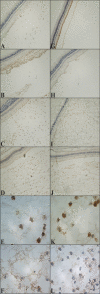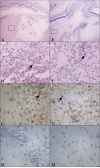The Streptococcus pneumoniae capsule is required for full virulence in pneumococcal endophthalmitis
- PMID: 21051708
- PMCID: PMC3053111
- DOI: 10.1167/iovs.10-5513
The Streptococcus pneumoniae capsule is required for full virulence in pneumococcal endophthalmitis
Abstract
Purpose: To determine whether Streptococcus pneumoniae capsule was necessary for pathogenesis of pneumococcal endophthalmitis.
Methods: An isogenic capsule-deficient strain was created using homologous recombination. New Zealand White rabbits were injected intravitreously with 10(2) colony-forming units (CFU) of the parent strain or the capsule mutant. Slit lamp examination (SLE), electroretinography, and myeloperoxidase activity were performed 24 and 48 hours postinfection (PI). Serial dilutions of vitreous were plated to quantitate CFU, eyes were extracted for histology, and host cytokine mRNA expression was determined.
Results: Eyes infected with the parent strain had significantly higher SLE scores than eyes infected with the capsule-deficient strain 24 and 48 hours PI (P < 0.001). CFU recovered from eyes infected with the capsule mutant were significantly fewer than CFU recovered from eyes infected with the parent strain 24 and 48 hours PI (P < 0.001). The parent strain caused a significantly greater decrease in retinal function and more retinal destruction than the mutant strain 48 hours PI (P = 0.026). Vitreal IL-1β, IL-6, and TNF-α were upregulated by both the parent and mutant strain 12 hours PI. By 48 hours PI, there was significantly more neutrophil infiltration in the vitreous infected with the parent strain.
Conclusions: Endophthalmitis caused by the encapsulated strain is more damaging to retinal function and structural integrity. These findings indicate that capsule is an important virulence factor of S. pneumoniae endophthalmitis, in contrast to keratitis, suggesting that the anatomic host site in pneumococcal ocular infections is important.
Figures






Similar articles
-
Contribution of pneumolysin and autolysin to the pathogenesis of experimental pneumococcal endophthalmitis.Retina. 2002 Oct;22(5):622-32. doi: 10.1097/00006982-200210000-00014. Retina. 2002. PMID: 12441729
-
Ocular virulence of capsule-deficient streptococcus pneumoniae in a rabbit keratitis model.Invest Ophthalmol Vis Sci. 2005 Feb;46(2):604-8. doi: 10.1167/iovs.04-0889. Invest Ophthalmol Vis Sci. 2005. PMID: 15671288
-
Assessment of Streptococcus pneumoniae capsule in conjunctivitis and keratitis in vivo neuraminidase activity increases in nonencapsulated pneumococci following conjunctival infection.Curr Eye Res. 2010 Sep;35(9):787-98. doi: 10.3109/02713683.2010.492462. Curr Eye Res. 2010. PMID: 20795860 Free PMC article.
-
[Current microbiologic problems. Pulmonary infection by Streptococcus pneumoniae. Current physiopathological aspects].Presse Med. 1999 Feb 27;28(8):442-9. Presse Med. 1999. PMID: 10093606 Review. French.
-
Cytokine Expression in Staphylococcal and Streptococcal Endophthalmitis.Biomed Hub. 2022 Jul 4;7(2):88-98. doi: 10.1159/000525330. eCollection 2022 May-Aug. Biomed Hub. 2022. PMID: 35950012 Free PMC article. Review.
Cited by
-
The Role of Pneumococcal Virulence Factors in Ocular Infectious Diseases.Interdiscip Perspect Infect Dis. 2018 Nov 13;2018:2525173. doi: 10.1155/2018/2525173. eCollection 2018. Interdiscip Perspect Infect Dis. 2018. PMID: 30538741 Free PMC article. Review.
-
Differential bacterial gene expression during experimental pneumococcal endophthalmitis.Ophthalmic Res. 2015;53(3):149-61. doi: 10.1159/000371713. Epub 2015 Mar 12. Ophthalmic Res. 2015. PMID: 25791614 Free PMC article.
-
Treatment of Bacillus cereus endophthalmitis with endoscopy-assisted vitrectomy.Medicine (Baltimore). 2017 Dec;96(50):e8701. doi: 10.1097/MD.0000000000008701. Medicine (Baltimore). 2017. PMID: 29390262 Free PMC article.
-
Combating pathogenic microorganisms using plant-derived antimicrobials: a minireview of the mechanistic basis.Biomed Res Int. 2014;2014:761741. doi: 10.1155/2014/761741. Epub 2014 Sep 14. Biomed Res Int. 2014. PMID: 25298964 Free PMC article. Review.
-
Bacterial capsules: Occurrence, mechanism, and function.NPJ Biofilms Microbiomes. 2024 Mar 13;10(1):21. doi: 10.1038/s41522-024-00497-6. NPJ Biofilms Microbiomes. 2024. PMID: 38480745 Free PMC article. Review.
References
-
- Mao LK, Flynn HW, Miller JD, Pflugfelder SC. Endophthalmitis caused by streptococcal species. Arch Ophthalmol. 1992;110:798–801 - PubMed
-
- Miller JJ, Scott IU, Flynn HW, Smiddy WE, Corey RP, Miller D. Endophthalmitis caused by Streptococcus pneumoniae. Am J Ophthalmol. 2004;138:231–236 - PubMed
-
- Nouri M, Terada H, Alfonso EC, Foster S, Durand ML, Dohlman CH. Endophthalmitis after keratoprosthesis: incidence, bacterial causes, and risk factors. Arch Ophthalmol. 2001;119:484–489 - PubMed
-
- Soriano F, Perez-Trallero E, Pallares R, et al. Streptococcus pneumoniae endophthalmitis: a study of 36 cases with special reference to antibiotic resistance and treatment options. Clin Microbiol Infect. 2006;2:519–526 - PubMed
-
- Ng EW, Samiy N, Cousins FV, et al. Implication of pneumolysin as a virulence factor in Streptococcus pneumoniae endophthalmitis. Retina. 1997;17:521–529 - PubMed
Publication types
MeSH terms
Substances
Grants and funding
LinkOut - more resources
Full Text Sources
Medical
Research Materials
Miscellaneous

